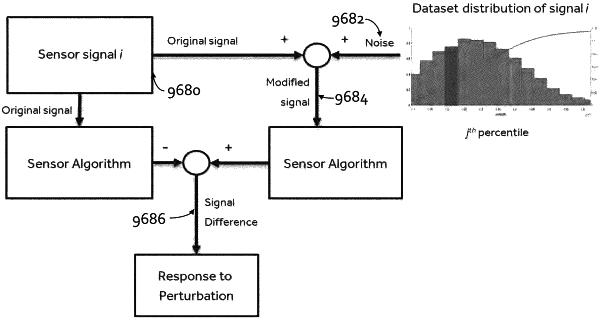| CPC A61B 5/1495 (2013.01) [A61B 5/14532 (2013.01); A61B 5/1468 (2013.01); A61B 5/14865 (2013.01); A61B 5/6849 (2013.01); A61B 5/686 (2013.01); G01N 27/026 (2013.01); G06N 5/022 (2013.01); G16H 20/17 (2018.01); G16H 40/40 (2018.01); G16H 50/30 (2018.01); G16H 50/70 (2018.01); A61B 5/0075 (2013.01); A61B 5/02055 (2013.01); A61B 5/021 (2013.01); A61B 5/024 (2013.01); A61B 5/1118 (2013.01); A61B 5/14546 (2013.01); A61B 5/1455 (2013.01); A61B 5/7203 (2013.01); A61B 5/7221 (2013.01); A61B 5/7267 (2013.01); A61B 5/742 (2013.01); A61B 2505/07 (2013.01); A61B 2560/0223 (2013.01); A61B 2560/0252 (2013.01); A61B 2560/0257 (2013.01); A61B 2562/028 (2013.01); A61B 2562/029 (2013.01); A61B 2562/164 (2013.01)] | 20 Claims |

|
1. A method for calibrating a glucose sensor, the method comprising:
performing a perturbation analysis for a plurality of sensor characteristic features of the glucose sensor, the perturbation analysis performed for each sensor characteristic feature of the plurality of sensor characteristic features by:
accessing a respective sensor characteristic feature signal,
determining a respective sensor glucose value based on the respective sensor characteristic feature signal,
determining a respective plurality of changes in the sensor glucose value based on adding a respective plurality of noise perturbations to the respective sensor characteristic feature signal, and
generating a respective perturbation response for the respective sensor characteristic feature, the respective perturbation response plotting degrees of change in the respective sensor characteristic feature, caused by the respective plurality of noise perturbations, against degrees of change in respective sensor glucose value, corresponding to the respective plurality of changes in the sensor glucose value;
selecting one or more sensor characteristic features from the plurality of sensor characteristic features based on the perturbation responses for the plurality of sensor characteristic features and based on a threshold value; and
calibrating the glucose sensor based on the selected one or more sensor characteristic features.
|